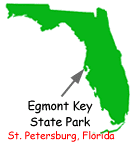| 
Reservations for
Florida State
Parks are now
made through
Reserve America,
toll free, at
1-800-326-3521
|
EGMONT
KEY STATE PARK
The island of Egmont Key has unique
natural and cultural histories which have made it a valuable resource since
the time settlers first arrived in Florida. Named in honor of John Perceval,
the second Earl of Egmont and member of the Irish House of Commons in 1763,
Egmont Key has had Spanish conquistadors and nuclear submarines pass its
shores as they entered Tampa Bay
HISTORY
In the 1830's, as shipping increased, so did the number of ships that were
grounded on the numerous sandbars around Egmont Key. On March 3, 1847, Congress
authorized funds to construct a lighthouse on Egmont. The construction was
completed in May,1848. Once completed, it was the only lighthouse between
St. Marks and Key West. When the Great Hurricane of 1848 struck, tides 15
feet above normal washed over the island and damaged the light. Another
storm in 1852 did additional damage and prompted Congress to appropriate
funds to rebuild the lighthouse and lightkeeper's residence.
At the end of the third Seminole War in 1858, Egmont Key was used by the
U.S. Army to detain Seminole prisoners until they could be transported to
Arkansas Territory.
In 1858, the lighthouse was
reconstructed to "withstand any storm." The new tower is 87
feet high with an Argard kerosene lamp and fixed Fresnel lens. Confederate
troops occupied the island when the Civil War began. Realizing they could
not defend their position, the Confederates evacuated Egmont, taking with
them the Fresnel lens from the tower. The Union navy used Egmont to operate
their Gulf Coast blockade of the Confederacy. Union troops raided Tampa
in an unsuccessful effort to locate the missing lens.
The lighthouse returned to
normal operation at the end of the war. After the Civil War, the lightkeeper,
his assistant and their families were the principal residents of the island
from 1866 to 1898.
Fort Dade was established on
Egmont Key when the Spanish-American War was imminent. When construction
was completed in 1906, Fort Dade was a small city of 300 residents with
electricity, telephones, movie theater, bowling alley, tennis courts,
hospital and a jail. The fort was deactivated in 1923.
The Tampa Bay Pilots Association,
established in 1886, set up operations on the island in 1926. When ships
approach Tampa Bay, a pilot boards the vessel in the main channel and directs
the ship to the docks. As the vessel leaves the dock the pilot guides it
out and returns to Egmont Key on one of the pilot boats. The work of the
pilots helps to protect the Bay from environmental damage that would result
from grounding and/or collisions.
PRESENT DAY
In 1939, the Lighthouse Service was transferred to the U.S. Coast Guard,
which has maintained the light as well as radio guidance equipment. The
Key was designated a National Wildlife Refuge in 1974, managed by the U.S.
Fish and Wildlife Service. Due to staffing limitations and increased public
visits, the Wildlife Service was unable to protect the resources on its
own. When the Coast Guard automated the light, Coast Guard personnel were
reassigned. The Florida Park Service began operations at Egmont Key on October
1, 1989, as part of a co-management agreement with the U.S. Fish and Wildlife
Service.
ACTIVITIES
Visitors can spend the day on the beach sunbathing, swimming in the warm
bay waters, walking through the historic ruins of Fort Dade, or walking
the brick paths that remain from the days Fort Dade was an active community
with 300 residents. A gopher tortoise can be seen
at almost every turn as you walk the historic paths. Many visitors are treated
to the sight of hummingbirds as well as other seabirds.
ACCESS
Egmont Key State Park is cooperatively managed by the Florida Department
of Environmental Protection, U.S. Fish and Wildlife Service and the U.S.
Coast Guard. Access to the island is by boat only. The park is located at
the mouth of Tampa Bay, southwest of Fort DeSoto Beach.
To visit Egmont Key State Park,
contact one of the following ferry services for schedules and fees.
Cortez Lady (941) 761-9777 ( departs from Cortez, south of Bradenton)
Capt. Bill (727) 867-8168,
Capt. Daves (727) 367-4336,
Capt. Franks (727) 345-4500,
Capt. Kidd (727) 360-2263,
Dolphin Landing (727) 360-7411,
Hubbards Sea Adventures (727) 398-6577. (departs from St. Petersburg area
and the beaches)

Egmont Key is located at the mouth of Tampa Bay, southwest of Fort DeSoto Beach. Access by private boat only.For more information on the park, write to:
Egmont Key State Park
4905 34th Street South, #5000
St. Petersburg, FL 33711
or call: (727) 893-2627.
View Larger Map
|
|